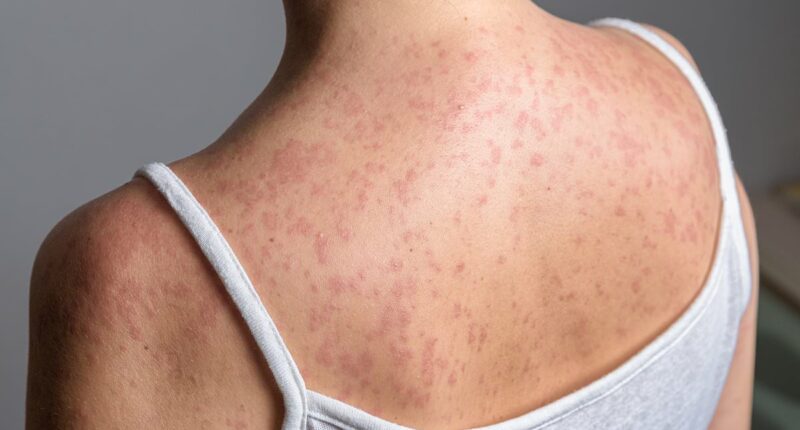Share this @internewscast.com
A measles outbreak has hit South Carolina, as cases of the potentially deadly virus hit record highs across the country.
The Public Health Department of South Carolina reported on Thursday that a confirmed outbreak has emerged in the northern part of the state, increasing the total number of reported cases to eight.
Five of the individuals caught the virus within the past month. DPH defines an outbreak as three or more cases that are linked to one another.
The department added that all those involved in the current outbreak were unvaccinated and didn’t have immunity.
Dr. Linda Bell, who serves as the state’s epidemiologist and leads the Health Programs Branch, mentioned that the source of infection for two individuals with measles remains unidentified.
She also highlighted that the department expects to discover more cases and advised individuals to avoid contact with others if they show any symptoms related to the virus.
Measles symptoms may include fever, cough, red eyes, and a runny nose, typically followed by a rash that starts on the face and then spreads throughout the body, usually lasting for five to six days.
Measles spreads through the air and remains airborne for up to two hours after the infected person leaves.

A measles outbreak has been reported in the upper region of South Carolina, with the Department of Health confirming eight cases in the area

Measles cases exceeded 800 in Texas in the last two years, with New Mexico and Arizona also reporting high numbers of infections

The description portrays measles as a highly contagious virus with symptoms such as fever, cough, red eyes, and a runny nose, leading to a rash starting on the face and spreading, generally persisting for five to six days.
DPH strongly urged anyone with symptoms to avoid contact with others due to the extremely contagious nature of measles.
Even those with mild early symptoms can spread the virus, and those infected can be contagious for four days before they even start to see a rash.
Health authorities emphasized the critical role of vaccination in stopping measles from spreading, noting its effectiveness in preventing infection stands at 97 percent.
Children are encouraged to receive two doses of the vaccine: the first between 1 year and 15 months old, and the second between 4 and 6 years old, according to DPH.
‘Measles-mumps-rubella (MMR) vaccination remains the most important tool for preventing measles infection and spread,’ Dr. Bell said.
‘We strongly encourage everyone to review their immunization records and make sure they are up to date on all recommended vaccinations, including MMR’.
So far this year, there have been 1,544 cases nationwide, a record high for the past 33 years, according to data from the Centers for Disease Control and Prevention.

Experts have advocated for the vaccine to prevent measles outbreaks. Many states have less than 90 percent vaccination rates
The last time measles cases exceeded 1,000 reported cases was in 1992, when 2,126 people contracted the virus.
The year with the highest number of recorded cases in the last 40 years was 1990, when 27,808 people contracted measles.
A year later, measles elimination efforts expanded throughout the US, and children aged 9-15 began receiving the vaccine, according to the World Health Organization.
Since 1997, measles infections remained under 200, with some years even falling under 50 reported cases.
However, cases have skyrocketed in recent years, and there have already been three confirmed deaths this year from the virus, according to the CDC.
The Minnesota Department of Health announced on Wednesday that the state has 10 new confirmed cases, bringing the total of infected individuals up to 18.
West Texas experienced a significant outbreak earlier this year, with 762 confirmed cases, including 99 hospitalizations, and two deaths in school-aged children.

The American Academy of Pediatrics issued a statement that advocated for vaccines and dispelled claims that the virus was treatable
Health and Human Services Secretary Robert F. Kennedy Jr. came under fire during the outbreak for promoting vitamin A and drugs budesonide and clarithromycin as recovery methods for measles.
The American Academy of Pediatrics dispelled the claim, releasing a fact sheet that read: ‘There is no scientific evidence that inhaled steroids like budesonide or oral antibiotics like clarithromycin are beneficial for treating measles.
‘Promoting medications to treat measles, particularly when those medications are not recommended, suggests that measles is treatable, which it is not’.
Daily Mail has reached out to the HHS for comment on recent measles outbreaks.















